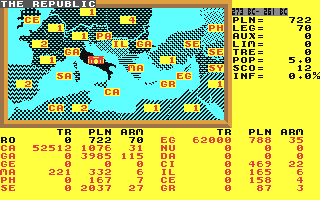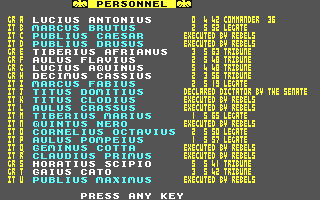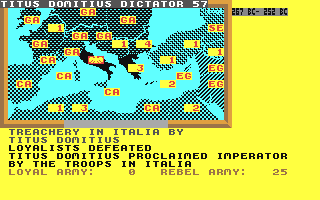|
Annals
of Rome's scenario represents the ultimate in long-range
wargaming. Strategically planning the invasion of a
country over a period of months telescopes into invisible
detail in the epic backdrop, and in this game you're
responsible for the construction and maintenance of
the whole Roman Empire. There's something breathtaking
about the grandeur of this design, which caught my imagination
when I reviewed this on the Spectrum at the beginning
of the year, and I'm disappointed to find that it has
mysteriously lost most of its inexplicable playability
in its translation to the Commodore.
Several
elements combine untidily to produce a simulation of
the historical conditions which moulded the fate of
nations in general, and Rome in particular. There are
economic forces, represented in an ineffectual way by
a selectable tax rate and a treasury full (or otherwise)
of gold. There are personalities, providing unexpected
human interest in a saga which you might expect to be
remote from the affairs of individuals, and, of course,
there is military conquest.

The
game opens in 273BC, by which time the Roman Republic
had gained control of Italy itself and was poised to
conquer the rest of the ancient map. The main display
shows a rather squashed version of what the known world
looked like around this time which is thankfully supplemented
by a map in the rulebook. Rome's rival powers are spread
across it, their dominion of regions indicated by a
race-specific pattern. When the game opens, the Gauls'
heavy black dots are smeared over most of Europe and
I learned from experience that it was expedient and
fairly easy to crush their dominance as soon as possible.
Before
going into combat, the token economics phase gives the
player the chance to set the tax rate between one and
two for the next phase. A high tax rate induces unpopularity,
and the popularity of a regime is an important determiner
of stability. I was unconvinced that being poor had
any detrimental effect on me anyway, and the rulebook
is most unclear on the matter.

Next,
the player is presented with a roll-call of Roman VIP's.
There are 21 characters at any one time, and they all
have individual, convincing-sounding Roman names like
Tiberius Cato and Aurelius Maximus (of course, to be
pedantic about it, Romans had three names, not two).
They all start out as senators, but can he turned into
commanders, legates and governors. Each has a personality
of his own which is defined by ability and loyalty ratings.
They age naturally, and as they die from phase to phase
they are replaced automatically. The first personnel
decision the player makes is whom to appoint governor
of Rome. Choosing a senator with a low loyally rating
will almost inevitably mean treachery, but this needn't
always be a bad thing.
If
the popularity of the regime is low, and it can drop
far below zero, a more damaging kind of treachery is
possible -- a governor in charge of a large force of
legions can decide to rebel and rampage across the empire
to take power in Rome. There's nothing to stop several
governors deciding to do this simultaneously, and in
fact a phase -- the civil war phase -- is set aside
for it. Part of the army usually remains loyal to the
state, and this means that you waste resources fighting
yourself. Civil war can be devastating, and to be avoided
if possible; it's dangerous to put any governor however
high his loyalty, in charge of too many men.

At
the start of the game Italia sits by itself on the map,
surrounded by enemy empires and possessed of a highly
efficient fighting force. Legionary forces are so much
better organised than the rabble of the rest of the
World that they have little difficulty in defeating
them, even when outnumbered two to one. In the combat
phase, each region of the world -- and there are twenty-eight
of them -- takes its turn in random order. The player
has to watch the rest of the world fighting its own
battles in the initial turns, and the Spectrum version
of this stage was infuriatingly slow. It has been speeded
up considerably in the Commodore version, but clumsily.
A disconcerting absence of sound effects of any kind
makes it difficult to follow what's going on. It's ridiculous,
of course, to expect the conquest of countries to be
accompanied by any sort of appropriate noise, and I
remember I made a sarcastic comment about the one supplied
with the Spectrum version, but silence is worse.
When
Italia gets its chance, the choice is fairly simple:
do nothing or send the legionaries marching into an
adjacent region and claim it. Each country has only
one move per turn, but if you capture a country before
it's had its move then its turn falls under your control.
This means that the order in which the countries move
become of paramount importance, and luck determines
whether you can capture five territories in one phase
or only one.

The
presence of an enemy in a country is indicated by a
number, counting in units of ten thousand. Confusingly,
the Roman armies are counted and shown in units of five
thousand. To take control of a territory, the Roman
army has to eliminate all opposition, which, as long
as you're careful in using a large enough force, it
usually has little difficulty in doing. The resolution
of combat has been speeded up again, and is now too
quick to be interesting, and once more it's conducted
in eerie silence.
Once
conquered, Roman possessions are under external and
internal threat. Adjacent enemy powers attempt to take
them from the player, and if the province is the homeland
of a particular race, the native population raise a
sizeable army of ploughshare-wielding peasants and attempt
to rebel turn after turn. Holding onto a homeland is
tricky, but it's worth it because gradually you can
starve an enemy race out of existence. Without access
to their treasury, they can't raise real troops and,
sat on for a sufficient number of decades, they dwindle
and die. The most powerful threat to the empire comes
from outside the map, from the masses of barbarians
who appear in historically scheduled waves in astronomical
numbers and who always win in the end. They are unstoppable
largely because they're uncontrollable.

With
some tactical practice it is not difficult to bring
the whole map under Roman control within a respectable
number of turns. The difficulty lies in keeping it that
way, with the threat of civil war and native rebellion
always simmering underneath the organised exterior,
and the threat of barbarian invasion on the horizon.
Theoretically it's possible to sustain the Roman Empire
long past its historical downfall, though the forces
operating against you are overwhelmingly powerful. Although
the Roman legionaries start out in 273BC as the best
soldiers in the world, by the time the Vandals and the
Huns arrive in the fifth century their methods are old-fashioned,
and the barbarian hordes have attained a degree of sophistication
which matches them equally. There's no such thing at
winning in this game.
|